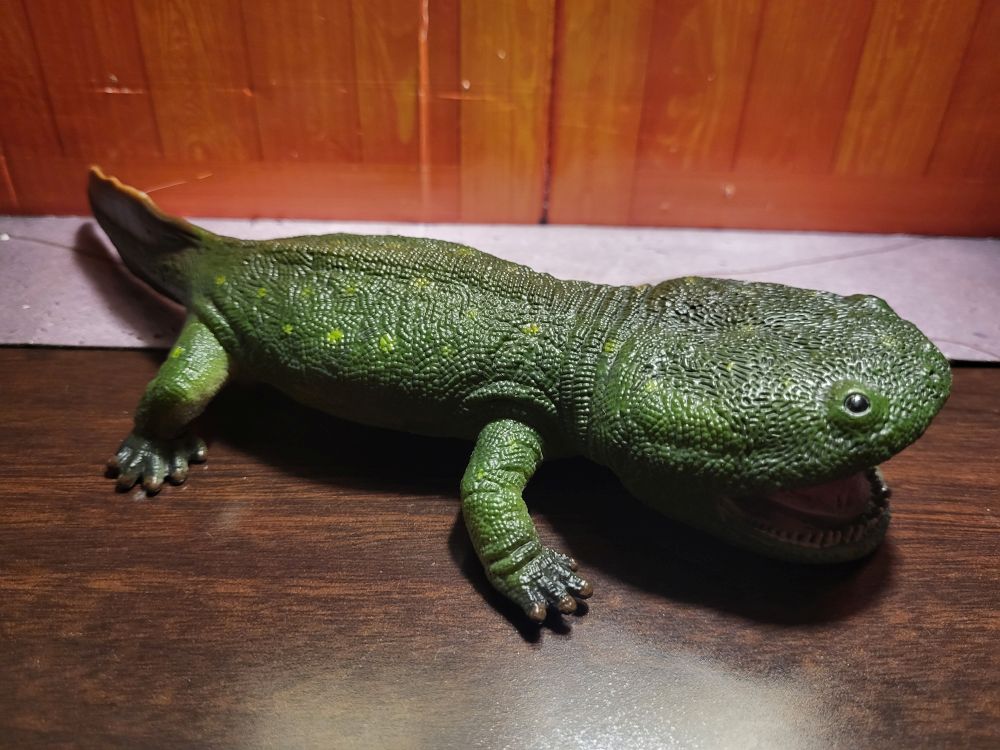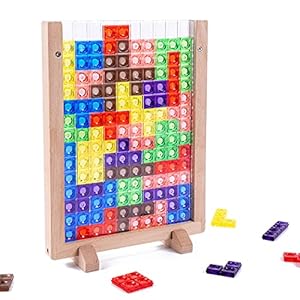
My sincerest due to Joyful Hen Toys for his or her generosity in sending me this determine to assessment right here. This determine is on the market over there, together with many extra prehistoric animals from quite a few fan favourite manufacturers like CollectA, Haolonggood, PNSO, Safari Ltd, and so many extra. Now let’s start the assessment!
It isn’t usually figures of prehistoric amphibians are made. In actual fact solely a handful have been constructed from just a few firms, most throughout or after the 1990’s. These with essentially the most outstanding choice have been from Play Imaginative and prescient’s 1998 Prehistoric Amphibians set, Kaiyodo’s Dinotales within the early to mid 2000’s, and Yowie’s Misplaced Kingdoms, additionally launched through the mid 2000’s. There have been a sprinkling of figures since, and so it was an excellent shock when CollectA had introduced like three years in the past from now that we’d be getting Koolasuchus of all issues. That is the primary time this animal has had a mass produced determine, and the way lengthy it’s been within the ready. And why Koolasuchus in any respect one may ask?
Shortly after it was described and named in 1997 by Anne Warren et al, it was given the highlight in BBC’s 1999 collection Strolling with Dinosaurs, and extra particularly the Spirits of the Ice Forest episode. Ever since I used to be a toddler after I first watched the collection, I had a fixation on this goofy wanting temnospondyl, with its massive head and tiny limbs, dwelling within the polar south, climbing somewhat dopey-like out of its pond through the hotter summer time interval, and returning as the cruel winter started. Because of its look within the collection, and with a surprisingly respectable quantity of display time it was given, it’s no shock it stays as one of many extra acquainted, if not well-liked prehistoric amphibians on the market. It additionally helps that it was one of many largest temnospondyls, and excluding their doubtless descendants, the lissamphibians (which incorporates all extant, or nonetheless dwelling amphibian genera), was one of many final of its sort, dwelling through the Early Cretaceous interval.

The title “Koolasuchus” is each named after Lesley Kool, who not solely discovered among the materials, but in addition helped put together it, and the Greek Souchos, for crocodile, as a consequence of many temnospondyls sharing an analogous bauplan with them. The species title “cleelandi” is known as after Mike Cleeland who discovered the holotype mandible. As talked about earlier Koolasuchus was from the polar south, notably from what’s now Victoria, Australia, and roughly lived through the Barremian-Aptian phases of the Early Cretaceous interval, 125–120 million years in the past. It was a part of the Wonthaggi Formation, and lived alongside an assortment of dinosaurs and early mammals, represented by scrappy stays at the moment. Whereas it was depicted as dwelling with Muttaburrasaurus and Leaellynasaura in Strolling with Dinosaurs, they have been separated by a number of million years aside, if not distance as nicely.

Regardless of its reputation, Koolasuchus itself is understood from poor fossil materials, the perfect of which consists of the holotype NMV P186213, a set of left and proper ramus, components of the mandible, and doubtlessly a partial cranium, although it stays but to be described (see the above paper linked from Warren et al, 1997, and moreover this paper from Warren and Marsicano, 2000). Most of its following reconstructions, together with the Strolling with Dinosaurs depiction, and even the topic of assessment right here, seems to be primarily based on its family like Siderops kehli, from the Early Jurassic. Siderops particularly is understood from a lot better stays then Koolasuchus, and was additionally present in Australia, although within the state of Queensland. The one recognized specimen is the holotype Q M F7882, which features a close to full cranium and a partial articulated skeleton, primarily lacking the decrease half of the limbs (Warren and Hutchinson 1983). Each Koolasuchus and Siderops belong to the household Chigutisauridae.

Now onto the determine itself. For starters, the determine is about 21.4cm/8.4 inches lengthy, and the pinnacle is about 5.08cm/2 inches at its widest. The size of Koolasuchus cranium (from the midline) is estimated to be about 65cm/25.6 inches (Steyer and Damiani, 2005), and mixed with the size of the determine’s head at about 6.35cm/2.5 inches, which might put this determine round 1:10 scale give or take. The determine is general a darkish inexperienced coloration, with a cream or pale yellow for the stomach. Although there’s additionally darkish brown coloration from the bottom right down to the tail fin, with some gentle inexperienced spots on the again as nicely. The mouth is usually pink, with a darkish wash within the texturing on the tongue and the roof of the mouth. The eyes are jet black, and the digits have been all painted brown at their suggestions.

The feel of the cranium on the determine bares resemblance to that of the various temnospondyl skulls on the market, though this pitted and grooved texture can also be discovered current on different non-temnospondyl animals as nicely. Quite it was uncovered or coated below pores and skin is a matter of debate. There are a selection of various speculation about what the pits and grooves would have been used for, corresponding to supporting blood vessels to expel carbon dioxide, or how the pores and skin adheres to the cranium. The paper describing Siderops suggests the cranium had sensory canals, or sulci as nicely, one thing Koolasuchus doubtless additionally had.

Transferring onto the physique’s integument, it’s coated in wonderful scales. This was a topic of debate when the determine was first revealed. With out extra materials from Koolasuchus, or different chigutisaurids, it’s arduous to say precisely if the scales are the right depiction for this animal, or if clean pores and skin like seen on many extant amphibians was extra doubtless. In any case it offers the determine a pleasant texture. Various kinds of scales, and even osteoderms are recognized from numerous temnospondyls throughout the group nevertheless, together with Broomistega putterilli (Fernandez, et al, 2013), Eryops megacephalus (Romer and Witter, 1941), Gerrothorax pulcherrimus (“G. rhaeticus” Nilsson, 1946), Laidleria gracilis (Warren, 2008), Melanerpeton tenerum (Werneburg, 2007; moreover preserves some sort of coloration sample), Peltobatrachus pustulatus (Panchen, 1959), Sclerocephalus haeuseri (Schoch and Witzmann, 2008; moreover Witzmann, 2007) and quite a few others.

Along with these examples, the not too long ago described Arenaerpeton supinatus (Hart, et al, 2023), a chigutisaurid like Koolasuchus, preserves a smooth tissue define from the stomach facet up. The define is at its widest on the stomach, doubtless a results of the carcass present process some “bloat-and-float” like different aquatic animals, because the paper suggests, however different facets (corresponding to across the arms) might be able to be inferred for its family going ahead. The fossil’s smooth tissue is described within the paper as being “coarsely textured”, and that it lacked dermal ossifications. This could be the closest concept we will get for Koolasuchus pores and skin, with out extra proof. In any case, I feel what CollectA gave it’s a protected interpretation.
The determine has a webbed tail of kinds, much like that of the extant critically endangered Axolotl. With out systematically researching each described species of temnospondyl (and belief me I attempted quite a few instances, with every leading to a burn out), there’s no strategy to say if the inspiration got here from any specific specimen. What I’ve come throughout is a few neotenic dissorophoideans depicted on this approach (just like the above talked about Melanerpeton tenerum), however even then I’m undecided whether or not there’s proof amongst them for such a characteristic, or if it stays purely speculative, pulled from extant amphibians just like the Axolotl. A plethora of paleoart additionally depicts temnospondyls with such a characteristic (although not on a regular basis). If anybody is aware of of any specific temnospondyls with any such tail morphology, please let me know within the feedback beneath.

In any case, in the event you like prehistoric amphibians, I undoubtedly suggest choosing this one up. The market might definitely use extra prehistoric amphibians, now that the remainder outdoors of this determine are lengthy retired. Hopefully this determine is profitable in promoting. I’d like to see CollectA do extra prehistoric amphibians (if not earlier tetrapodomorphs like Tiktaalik), temnospondyls or in any other case, sooner or later.
Trending Merchandise












